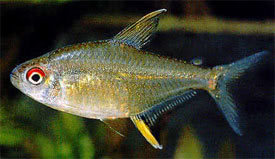
 Magyarul / Hungarian
Magyarul / Hungarian


- Scientific name: Hyphessobrycon pulchripinnis
- Common name: Lemon tetra
- Group: Characins
- Habitat: South America; Tocantin river (Brazil).
- Size: 4 cm
- Biotope: Widespread throughout South America, but not found in great numbers.
- Social behavior: The Lemon Tetra is ideal for a community aquarium with other peaceful fish.
- Diet: The Lemon Tetra really benefits from "color" foods. Since they are omnivorous these fish will generally eat all kinds of live, fresh, and flake foods. To keep a good balance give them a high quality flake food everyday. Feed brine shrimp (either live or frozen) or blood worms as a treat.
- Breeding: Hard
- Tank: Minimum 70 litres
- Population: 5 fishes for 70 litres
- Decoration: Dark substrate and roots, rocks.
- Temperature: 22-27°C
- pH: 6,5-7.
- Hardness: 4,5-7,3 NK°
- Lifespan: 5 years
Description: Typical for the Genus. Medium tall and very compressed. Grows too about two inches.The top of the eye is very Red. The end and edge of the Dorsal fin is Black. The back rays on the Anal fin are Black. The front ones are bright Yellow. The body is transparent with a slight Yellowish tinge. A Iridescent stripe extends laterally from the gill cover to the start of the Caudal fin.
An Easily kept fish, the Lemon Tetra can be housed in almost any community aquarium. For best show the tank should be small to medium in size and contain from ten to fifty-five gallons of water. The water should be clear, soft to medium in hardness and with a pH on the acidic side. The temperature should be maintained between 72° and 79°. As with all fish a portion of the water should be changed monthly. Feeding is no problem as they will accept all flake food as well as any live food you can provide. The tank should have open areas for swimming as well as areas with dense vegetation for hiding. The Lemon tetras subtle colors can be enhanced through the use of a dark substrate
The lemon Tetra is not one of the easiest Tetras to spawn. It seems that the females have trouble expelling the eggs and so several females should be combined with one male to increase the chance of success. Eggs are laid in fine leafed plants in the scattering method. The eggs hatch in about twenty-four hours and the mortality rate is fairly high. Once the young survive the first couple of days they prove to be very hardy. The parents give no care and will eat the eggs and young and so should be removed as quickly as possible after spawning.


























